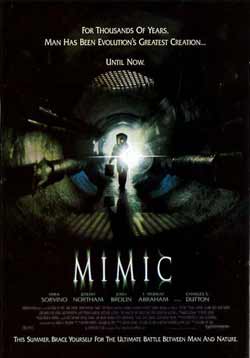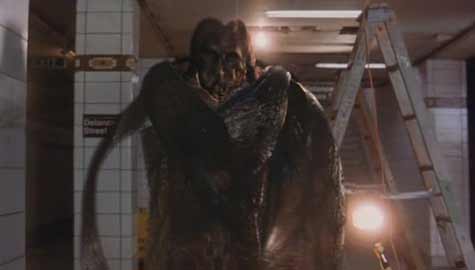
Last week, I discussed Guillermo del Toro’s 1993 debut, Cronos, and now I'm back to examine his 1997 thriller Mimic, which opens with dire circumstances: a sickness akin to a Biblical plague has broken out in New York, striking down an entire generation of children. No cure can be found, no treatments are working, and in desperation the CDC turns to an entomologist to attack the source of the disease with one of mankind’s oldest pests—the common cockroach.
Given the resilience of the insects, Dr. Susan Tyler (Mira Sorvino) resorts to genetically splicing DNA to create the Judas Breed, a super predator that eradicates the plague carriers. As they are designed to be sterile and die out once their work is done, Dr. Tyler and her husband, Peter Mann (Jeremy Northam) of the CDC, promptly move on with their lives.
Fast-forward to three years later, when strange happenings in the city’s subways prove that the Judas Breed did not die out as expected. With their genetically modified metabolism, they have been breeding and evolving at exponential rates. Until the insect has begun to mimic its new prey…
Mann and his fellow CDC investigator Josh (Josh Brolin) descend to an abandoned subway station accompanied by police officer Leonard (Charles S. Dutton) in search of the Judas Breed. Meanwhile, an autistic child and his shoe-shining grandfather Manny (Giancarlo Giannini) stumble into the nest. It isn’t long before they all discover the truth behind the disappearing homeless in the tunnels.
 Sure, it’s a typically ridiculous set-up for a monster flick. One of the oldest tropes is at work here; the science gone wrong plot has been around since Shelley’s Frankenstein. Dr. Tyler and Mann’s efforts are rooted in the noblest of intentions—who could blame them for playing God, after all, when the lives of children were on the line?—but it’s still the familiar cautionary tale of how easily meddling with nature can turn against us. There’s a reason certain plots have become so tried-and-true, and del Toro gets plenty of mileage out of this one.
Sure, it’s a typically ridiculous set-up for a monster flick. One of the oldest tropes is at work here; the science gone wrong plot has been around since Shelley’s Frankenstein. Dr. Tyler and Mann’s efforts are rooted in the noblest of intentions—who could blame them for playing God, after all, when the lives of children were on the line?—but it’s still the familiar cautionary tale of how easily meddling with nature can turn against us. There’s a reason certain plots have become so tried-and-true, and del Toro gets plenty of mileage out of this one.
And while studio interference means the ending is heavy-handed and bombastic, there’s still plenty to enjoy in del Toro’s first film made for American audiences. From the opening credits, evocative of Se7en’s in stylization and tone, the darkly rich atmosphere is evident. This is a story told almost completely in subterranean darkness. Fitting, when monster bugs are your villains. This evokes a claustrophobic air and only encourages the audience’s age-old fears of what could be lurking in the shadows.
Then there’s the Judas Breed itself. An unsettling cross between a cockroach and a praying mantis, they’re big, they’re slimy, and they buzz and click in a way that sets your teeth on edge. Designed by Rob Bottin, known for his superb work on John Carpenter’s The Thing, they’re sure to make anyone squirm.

One of my favorite moments is about midway through the film. Dr. Tyler has been waiting at a subway stop for her husband, looking at Polaroid shots of a giant dead bug fished out of the water treatment plant. Just as she recognizes the strange patterns on the insect’s wings, a P.A. announcement warns that the stop is about to close for the night. She gets up to leave, only to notice a strange shadow cast across the wall, as if someone very tall and thin is standing between the columns waiting for a train.
The audience knows by now that this is no man—that the mysterious Long John and Mr. Funny Shoes people whisper about isn’t even human—and it’s a great, unsettling moment. I’ve always found things that fall under the Uncanny Valley, beings and objects that look humanoid but are anything but, to be especially creepy. Mimic certainly delivers on that front.
This being a del Toro film, there’s a lot of significance placed in objects and roles. A zealous, overbearing grandmother had a huge impact on the director’s childhood; as a result, the trappings of religion are often used to underscore tension and the sense that things are not quite right.
Catholic imagery is everywhere, particularly with the character Manny, who always has his rosary wrapped around one wrist. One of the first attacks takes place in a church tucked away down a dirty alley. The garish neon cross above the door and religious statues wrapped in plastic sheeting—like corpses at the morgue, or pupae in their cocoons—add to the sense that God has forsaken this city after scientists dared to usurp His place.
While Dr. Tyler and Mann are happily married, their attempts to conceive have always failed. The irony is inescapable: the woman who created an entirely new species to save the children of New York can’t have a child of her own. Dr. Tyler and Mann, in a sense, have to atone for their past sins before they can have what they most want.

Sacrifice for and because of children is a theme that del Toro constantly returns to; and unlike many horror directors, he refuses to follow one of the few cardinal rules of the genre. In his films, children are not always safe. Sometimes there won’t be a last minute rescue purely on the merits of youth or innocence.
Mimic is hardly the movie del Toro wanted to make. As his first foray into English-speaking cinema, his hands were tied by the studio’s demands. It suffered several setbacks and contested edits, resulting in a film that doesn’t wholly gel and was deeply frustrating for its director.
But it’s still a fun horror flick, with some genuine scares and a few great moments and visuals. Hardly the worst the late 90’s had to offer. And it served a vital function: it exposed a wider audience to del Toro’s aesthetics and name, paving the way for his future films.
So if you’re not too squeamish about cockroaches, check Mimic out some night when you’ve got an hour and a half to spare. It’s currently streaming on Netflix if that sweetens the pot. And if you're a Walking Dead fan, a certain crossbow-wielding badass might just make an appearance.
Angie Barry wrote her thesis on the socio-political commentary in zombie films. Meeting George Romero is high on her bucket list, and she has spent hours putting together her zombie apocalypse survival plan. She also writes horror and fantasy in her spare time, and watches far too much Doctor Who. You can find her at Livejournal.com under the handle “zombres.”
Read all posts by Angie Barry at Criminal Element.

I think I watched half of this on TV when I was younger. I had no idea it was one of his films! Definitely adding to the Netflix queue. 🙂
I remember loving this movie the first time I saw it.